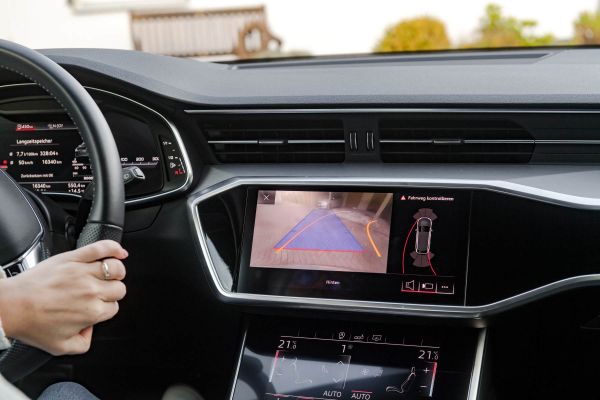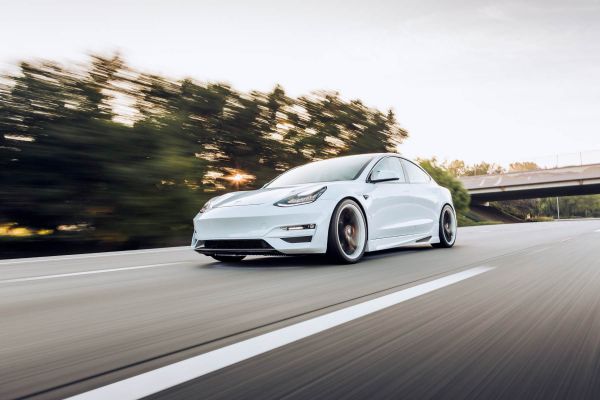Assistance systems in the car: These are mandatory for new cars

The ABS anti-lock braking system, the ESP stabilization program or daytime running lights have been mandatory for all new cars in the EU for some time. From July 2024, newly sold cars must also be equipped with, among other things, a drowsiness and attention warning system, as well as lane keeping and emergency brake assist. The new regulations are quite positive: road safety increases, driving becomes more comfortable and in general, the additional support should also lead to more relaxed travel. The good news for electric car drivers: In terms of assistance systems, electric cars are usually better equipped than comparable combustion engines.
The EU prescribes certain assistance systems for new cars
An EU regulation will prescribe a number of driver assistance systems for new cars from summer 2024 . For all those who want to know exactly: Specifically, it is the "Regulation No. 2019/2144 on the type-approval of motor vehicles and their trailers and of systems, components and separate technical units intended for such vehicles, with regard to their general safety and the protection of vehicle occupants and vulnerable road users".
The idea of safety was the guiding principle for the regulation. According to EU statistics, up to 95 percent of all road accidents are due to human error. The EU Commission expects that these mandatory assistance systems will save around 25,000 lives and prevent at least 140,000 serious injuries by 2038.
The introduction of the new assistance systems will take place in two stages:
From July 6, 2022:
- For all newly homologated vehicles: This means that all newly designed vehicle models that go through the type-approval process from this date onwards must be equipped with certain new assistance systems. This regulation therefore applies to new vehicle models that will be launched on the market for the first time from this date.
From 7 July 2024:
- For all new cars: From this date, all newly sold vehicles, regardless of their model year or type approval, must be equipped with the mandatory assistance systems. This applies to all new cars that are then registered for the first time, even if the model itself was already on the market before 2022. Manufacturers must have converted their models accordingly by the deadline, as all new vehicles on the market must now meet the current safety standards.
The advanced assistance systems in cars not only improve safety, but also significantly increase driving comfort.
Please note: if you buy a used electric car that received its type approval before 6 July 2022, it is possible that this vehicle is not equipped with the new assistance systems that will be mandatory from 2022. Which systems are actually included (added as standard or optionally by the previous owners) can only be revealed by looking at the car documents. In addition, the new regulations do not apply retroactively to models that have already been registered. This means that there is also no obligation to convert or retrofit used cars with type approval before July 6, 2022. For the new electric cars in 2024, however, the systems are already regularly "on board".
Which assistance systems are now mandatory in the car?
According to the EU regulation, the following assistance systems must now always be on board new cars:
- Emergency Brake Assist
- Lane Keeping Assist
- intelligent speed assistant
- Adaptive brake light
- Accident data recorder
- Fatigue detection
- Reversing assistant
- Head impact protection
- Alcohol-sensitive immobilizer
Emergency Brake Assist
In certain dangerous situations, the Emergency Brake Assist brakes automatically to prevent a collision. This is made possible by optical distance and speed measurements using radar, lidar (distance measurement with light pulses) and camera systems that transmit data to the control unit. It must be possible to detect obstacles and moving vehicles. The wizard can be manually deactivated and automatically turns on again when it is restarted.
Lane Keeping Assist
The Emergency Lane Keeping Assist warns if the vehicle leaves the lane unintentionally. In contrast to conventional lane departure warning systems, emergency systems intervene more aggressivelywhen an emergency situation is detected by steering strongly to keep the vehicle on the road or away from oncoming traffic. If the assistant is unable to work reliably due to deficiencies in the road infrastructure, it switches off automatically and informs the driver in the cockpit. After a restart, the assistant is active again.

The assistance systems that have been mandatory since July 2024 also include the emergency lane departure warning system, which actively intervenes in dangerous situations.
Intelligent speed assistant
The intelligent speed assistant warns drivers as soon as the permissible speed is exceeded. It obtains its guide values from traffic sign recognition and/or data from navigation services. The system activates with the ignition and can be deactivated manually.
Adaptive brake light
The adaptive brake light indicates to other road users that the vehicle in front of them is braking sharply. During normal braking, the brake lights light up as usual, while during an emergency braking, with a delay of more than 6 m/s and a speed of over 50 km/h, the brake lights flash several times per second. When the vehicle comes to a standstill, the hazard lights turn on and the brake lights are lit continuously.
Accident data recorder
The accident data recorder, also known as "event-related data recording" or "black box", stores data immediately before, during and after a collision. The data collected includes speed, braking, position, inclination and information from the eCall emergency call system, which has been mandatory since 2018 and automatically informs 112 in the event of an accident. The recording and storage are anonymized, and during normal driving, the information is also deleted every second. Only when a collision occurs is the collected data stored in the car in a time frame of five seconds before and 0.3 seconds after the accident. This information can later help to reconstruct the course of the accident. The police do not have access to the data from the outset, as a rule, you as a driver must agree to a reading. In the course of criminal proceedings, however, a court can also issue a corresponding order. The accident data recorder cannot be deactivated and is also mandatory in both partially and fully autonomous vehicles.
Fatigue detection
Since 2022, drowsiness detection has been mandatory in newly developed vehicles to prevent accidents caused by microsleep. The drowsiness warning is therefore already standard in many new cars. Driving behaviour is analysed by continuously recording eye or eyelid movements and/or steering movements. If there are signs of fatigue or decreasing concentration, the driver is asked acoustically and visually (by means of a symbol such as a coffee cup) to take breaks.
Reversing assistant
The reversing assistant is supposed to make parking out of a parking space and reversing safer. It detects pedestrians or obstacles behind the vehicle and warns the driver when reversing – usually by the well-known beep-Gnoise (from the parking or distance sensors on the rear bumper). New vehicles also show images from the reversing camera on the display and display information such as "obstacle detected" or "object approaching".This can prevent accidents that could happen, for example, when leaving a parking space with limited visibility.
Head impact protection
In areas of the vehicle that often come into contact with the heads of cyclists and pedestrians in an accident, such as the front of the vehicle and the windscreen, head impact protection must be integrated. The implementation is done through various measures, such as energy-absorbing materials (which absorb the impact) and active bonnets (is raised slightly to create a larger buffer between the pedestrian's head and hard engine components). The design of the windshields (installation of laminated glass) and the design of the vehicle fronts (reduction of the impact angle) must also be adapted. The additional protection must be proven by stricter crash tests.
Alcohol-sensitive immobilizer
In the future, all new cars will have to have a standardised interface that allows an alcohol-sensitive immobiliser to be retrofitted. The recording device itself (into which you would have to blow before starting to have the blood alcohol level determined) is not part of the regulation. Already known systems work with a breath alcohol device that only activates the ignition after a positive breath test. The background: Drinking and driving is one of the main causes of serious road accidents, and the introduction of alcohol-sensitive immobilizers is intended to prevent drivers from starting their cars when they are drunk.
Even if the mandatory installation of the recording device may still be a long time coming (some legal and technical measures would still be necessary in advance, for example, to rule out misuse and manipulation, and general principles of German traffic law with regard to appropriateness and freedom of action also stand in the way of the whole thing), a functioning interface is at least available. Because the recording device has long been allowed to be installed voluntarily. And it is already being used by companies from the taxi and bus industry and logistics companies.
Assistance systems in electric cars are superior to combustion engines
Of course, electric cars are also often equipped with a variety of assistance systems that increase both safety and driving comfort. Thanks to the intensive integration of electronics and the use of modern architectures, electric cars are often better equipped than many combustion vehicles. Many manufacturers of electric cars rely on state-of-the-art technologies such as artificial intelligence to continuously improve the assistance systems in their cars.
E-car vs. combustion engine: 3 models in comparison
Below are some models and their corresponding combustion engine versions in comparison, which clearly demonstrate the superiority of electric cars in terms of their assistance systems.
- Audi Q8 e-tron vs. Audi Q7:
Audi's Q8 e-tron offers a more comprehensive range of assistance systems compared to the relatively similarly dimensioned Audi Q7. The Q8 e-tron already has adaptive cruise control, lane departure warning, traffic sign recognition and a 360-degree camera system as standard. Many of these systems are only available in higher trim levels on the Q7 or at an additional cost.

Compared to the similarly dimensioned Audi Q7, the Q8 e-tron offers a more comprehensive range of assistance systems.
- VW ID.4 vs. VW Tiguan:
The VW ID.4 is also better equipped than the combustion engine Tiguan. The electric SUV from Volkswagen, for example, has Travel Assist as standard, which combines adaptive cruise control, lane departure warning and traffic sign recognition. These systems are usually only available in higher-priced variants on the Tiguan.
- Hyundai Kona Electric vs. Hyundai Kona:
The Hyundai Kona Electric, which has been available since 2023, is better equipped as standard in many markets than the identical combustion engine version. The small electric SUV has more advanced driver assistance systems such as autonomous emergency braking assist, adaptive cruise control and lane following assist, which are not available in the basic version of the combustion engine Kona.
Conclusion: More safety as standard thanks to assistance systems
The new EU regulation on the obligation to use driver assistance systems in new cars represents an important step towards improving road safety. By integrating such systems as standard in all new vehicles, many accidents can be prevented and numerous lives can be saved. However, this step not only contributes to safer roads, but should also promote further technical development in the coming years.
How this can work can be easily observed in electric cars. Many of the electric cars available today are better equipped with assistance systems than their combustion engine counterparts. This is due to the modern platforms on which electric cars are developed and the stronger focus on software and electronics – keyword "connected car". The advanced assistance systems in electric cars not only improve safety, but also significantly increase driving comfort – and this is usually already the case in the basic version.
However, there is a catch: it can be assumed with a high degree of probability that the integration of extensive and increasingly complex driver assistance systems will continue to increase vehicle prices on average. According to ADAC1, the cost of small cars (combustion engines and e-cars combined) has already risen by about 73 percent compared to ten years ago, which is partly due to the advanced technology installed in these vehicles. For example, the growing number of sensors, cameras, and computer chips required for these systems is contributing to the increased cost of production.
Post a Comment for "Assistance systems in the car: These are mandatory for new cars"